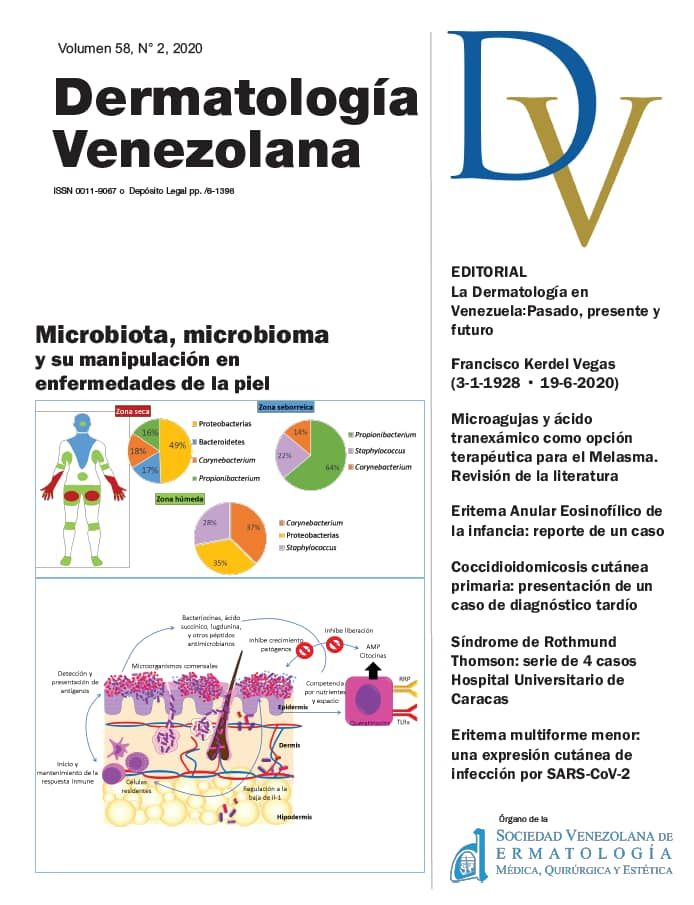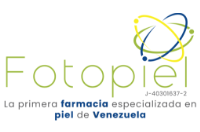Microbiota, microbioma y su manipulación en enfermedades de la piel.
Palabras clave:
Microbiota, microbioma, microbiota cutánea, microbioma cutáneo, probióticos.Resumen
Cada vez, existe más evidencia de que el microbioma, juega un papel importante en la modulación de la respuesta inflamatoria y las enfermedades, siendo el equilibrio entre cepas patógenas, oportunistas y beneficiosas necesario para el mantenimiento de la homeostasis. El microbioma varía entre los sujetos debido a gran cantidad de factores endógenos y exógenos. Las alteraciones en este equilibrio pueden predisponer al huésped a ciertas enfermedades. En la actualidad, se ha demostrado la utilidad del uso de probióticos en múltiples patologías tanto para prevención como para tratamiento. La microbiota cutánea, se adapta y modifica en las diferentes etapas de la vida y se ha visto implicada en procesos tan simples como la cicatrización de heridas hasta patologías complejas como la dermatitis atópica, el acné y la rosácea. En esta monografía se revisará la importancia de la microbiota, el microbioma y su manipulación en enfermedades de la piel.
Microbiota, microbiome and its manipulation in skin diseases.
Summary
There is increasing evidence that the microbiome plays an important role in the modulation of the inflammatory response and diseases, with the balance between pathogenic, opportunistic and beneficial strains being necessary for the maintenance of homeostasis. The microbiome varies between subjects due to a large number of endogenous and exogenous factors. Alterations in this balance can predispose the host to certain diseases. At present, the usefulness of the use of probiotics in multiple pathologies has been demonstrated for both prevention and treatment. The cutaneous microbiota adapts and modifies in the different stages of life and has been involved in processes as simple as wound healing to complex pathologies such as atopic dermatitis, acne and rosacea. In this review, the importance of the microbiota, the microbiome and its manipulation in skin diseases is developed.
Keywords: microbiota; microbiome; cutaneous microbiota; cutaneous microbiome; probiotics.
Referencias
Emiola A; Zhou W; Oh J. An enhanced characterization of the human skin microbiome: a new biodiversity of microbial interactions. BioRxiv [Internet].2020 [citado 30 Mar 2020]; Disponible en: https://doi.org/10.1101/2020.01.21.914820
Balato A, Cacciapuoti S, Di Caprio R, et al. Human Microbiome: composition and role in inflammatory skin diseases. Arch. Immunol. Ther. Exp. [Internet].2018 [citado 02 Feb 2020]. Disponible enhttps://doi.org/10.1007/s00005-018-0528-4
Norreslet L, Agner T, Clausen M. The skin microbiome in inflammatory skin diseases. Curr. Derm. Rep. [Internet].2020 [citado 05 Abr 2020].9:141-151. Disponible en: https://doi.org/10.1007/s13671-020-00297-z
Turnbaugh P; Ley R; Gordon J. The human microbiome project: exploring the microbial part of ourselves in a changing world. Nature. 2007;449(7164):804-810
Knackstedt R, Knackstedt T, Gatherwright J. The role of topical probiotics in skin conditions: A systematic review of animal and human studies and implications for future therapies. Exp. Dermatol. 2020;29:15-21.
Kong H. Microbiome of the skin. En: Kang S, Amagai M, Bruckner A, et al, eds. Fitzpatrick’s dermatology. Vol1.9na ed. EEUU: McGraw-hill;2019. p.253-264.
Huttenhower C, Gevers D, Knight, R, et al. Structure, function and diversity of the healthy human microbiome. Nature 2012;486: 207–214.
Salava A, Lauerma A. Role of the skin microbiome in atopic dermatitis. Clin Transl Allergy [Internet]. 2014 [citado 03 Mar 2020];4:33. Disponible en: https://doi.org/10.1186/2045-7022-4-33
Sanford JA, Gallo RL. Functions of the skin microbiota in health and disease. Semin. Immunol. 2013;25(5):370-377
Paetzold B, Willis J, Pereira J, et al. Skin microbiome modulation induced by probiotic solutions. Microbiome. 2019;7(1):95.
Byrd A, Belkaid Y, Segre J. The human skin microbiome. Nature. 2018;16:143-155.
Yu Y, Dunaway S, Champer J, et al. Changing our microbiome: probiotics in dermatology. BJD.2019;182(1):39-46.
Zeeuwen P; Kleerebezem M; Timmerman H; et al. Microbiome and skin diseases, Current Opinion in Allergy and Clinical Immunology. 2013; 13(5): 514-520
Turnbaugh P; Ley R; Gordon J. The human microbiome project: exploring the microbial part of ourselves in a changing world. Nature. 2007;449(7164):804-810
McBain AJ, O'Neill CA, Amezquita A, et al. Consumer Safety Considerations of Skin and Oral Microbiome Perturbation. Clin Microbiol Rev [Internet]. 2019 [citado: 02 feb 20];32(4):e00051-19. Disponible en: doi:10.1128/CMR.00051-19
Bay L, Barnes CJ, Fritz BG, et al. Universal dermal microbiome in human skin. mBio [Internet]. 2020 [citado: 19 Mar 2020];1:e02945-19. Disponible en: https://doi.org/10.1128/mBio.02945-19
Schoch JJ, Monir RL, Satcher KG, et al. The infantile cutaneous microbiome: A review. Pediatr. Dermatol [Internet]. 2019 [citado: 02 feb 2020]; 36: 574– 580. Disponible en: https://doi.org/10.1111/pde.13870
Weyrich LS, Dixit S, Farrer AG, et al. The skin microbiome: Associations between altered microbial communities and disease. Australas J Dermatol [Internet].2015[citado: 05 feb 2020];56(4):268‐274. Disponible en: doi:10.1111/ajd.12253
Bewick S, Gurarie E, Weissman JL, et al. Trait-based analysis of the human skin microbiome. Microbiome [Internet]. 2019 [citado: 02 feb 2020];7:101. Disponible en: https://doi.org/10.1186/s40168-019-0698-2
Underhill DM, Iliev ID. The mycobiota: interactions between commensal fungi and the host immune system. Nat Rev Immunol. 2014;14(6):405‐416.
Tiew PY, Mac Aogain M, Ali NABM, et al. The Mycobiome in Health and Disease: Emerging Concepts, Methodologies and Challenges. Mycopathologia [Internet]. 2020 [citado 03 mar 2020];185(2):207‐231. Disponible en: doi:10.1007/s11046-019-00413-z
Dimitriu PA, Iker B, Malik K, et al. New Insights into the Intrinsic and Extrinsic Factors That Shape the Human Skin Microbiome. mBio [Internet]. 2019 [citado 02 feb 20];10(4):e00839-19. Disponible en: doi:10.1128/mBio.00839-19
Wieërs G, Belkhir L, Enaud R, et al. How Probiotics Affect the Microbiota. Front CellInfect Microbiol [Internet]. 2020 [citado: 31 mar 20];9:454. Disponible en: doi:10.3389/fcimb.2019.00454
Grice EA, Segre JA. The human microbiome: our second genome. Annu Rev Genomics Hum Genet [Internet].2012 [citado: 10 feb 2020];13:151‐170. Disponible en: doi:10.1146/annurev-genom-090711-163814
Brandwein M, Katz I, Katz A, et al. Beyond the gut: skin microbiome compositional changes are associated with BMI. Human microbiome journal [Internet]. 2019 [citado: 02 feb 20]. Disponible en: https://doi.org/10.1016/j.humic.2019.100063
Chau TA, McCully ML, Brintnell W, et al. Toll-like receptor 2 ligands on the staphylococcal cell wall downregulate superantigen-induced T cell activation and prevent toxic shock syndrome. Nat Med [Internet]. 2009 [citado: 20 feb 2020];15(6):641‐648. Disponible en: doi:10.1038/nm.1965
Lai Y, Di Nardo A, Nakatsuji T, et al. Commensal bacteria regulate Toll-like receptor 3-dependent inflammation after skin injury. Nat Med [Internet]. 2009 [citado 04 mar 2020];15(12):1377‐1382. Disponible en: doi:10.1038/nm.2062
Gallo RL, Nakatsuji T. Microbial symbiosis with the innate immune defense system of the skin. J Invest Dermatol [Internet]. 2011 [citado: 10 mar 2020];131(10):1974‐1980. Disponible en: doi:10.1038/jid.2011.182
Hadian Y, Fregoso D, Nguyen C, et al. Microbiome-skin-brain axis: A novel paradigm for cutaneous wounds. Wound Repair Regen [Internet]. 2020 [citado:26 mar 2020];28(3):282‐292. Disponible en: doi:10.1111/wrr.12800
Simpson E, Leung D, Eichenfield L, et al. Atopic dermatitis. En: Kang S, Amagai M, Bruckner A, et al, eds. Fitzpatrick’s dermatology. Vol1.9na ed. EEUU: McGraw-hill;2019. p.363- 381
Bouslimani A, Da Silva R, Kosciolek T, et al. The impact of skin care products on skin chemistry and microbiome dynamics. BMC Biol[Internet]. 2019 [citado: 17 feb 2020];17(1):47. Disponible en: doi:10.1186/s12915-019-0660-6
FAO Technical Meeting Report on PREBIOTICS: Food Quality and Standards Service (AGNS) Food and Agriculture Organization of the United Nations (FAO); 2008. Disponible en: http://www.aattaa.eu/index/en/company/download/1262610500.html, visitado el: 18 de Abril de 2020.
Seite S, Bieber T. Barrier function and microbiotic dysbiosis in atopic dermatitis. Clin Cosmet Investig Dermatol [Internet]. 2015 [citado: 22 feb 2020]; 8:479‐483. Disponible en: doi:10.2147/CCID.S91521
McAleer M, O’Regan G, Irvine A. Atopic dermatitis. En: Bolognia J; Schaffer J; Cerroni L. (ed). Dermatology. 4th ed. China: Elsevier;2018. p.211-212
Zaenglein A; Thiboutot D. Acne vulgaris. En: En: Bolognia J; Schaffer J; Cerroni L. eds. Dermatology. 4th ed. China: Elsevier;2018. p:590
Descargas
Archivos adicionales
Publicado
Número
Sección
Licencia
Publicado por la Sociedad Venezolana de Dermatología Médica, Quirúrgica y Estética







